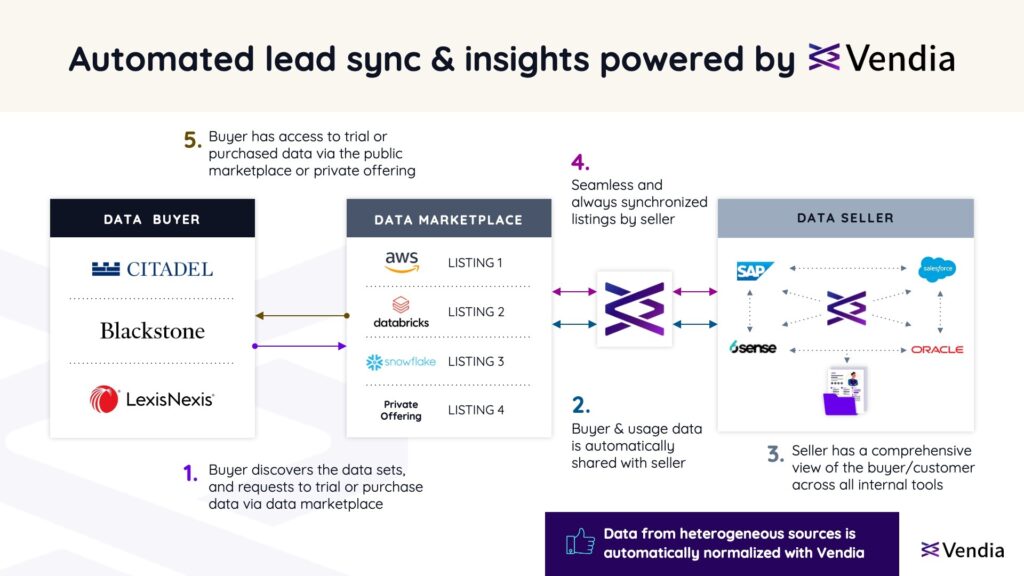The rise of data marketplaces: Fueling digital transformation across industries
The data gold rush is in full swing! We tackled data monetization strategies and their challenges in a previous post, including complexities of distribution, data security concerns, and the lack of customer insights for data product sales. Now, let’s shift our focus on a key player in the data commerce landscape: cloud-based data marketplaces. Platforms like Snowflake, Databricks, Datarade, and a few others, are fueling a digital transformation wave across industries. By offering a way to access external third-party data seamlessly and securely, these platforms empower organizations/buyers to unlock new revenue streams and market opportunities by deriving and deciphering emerging trends. With the data marketplace boom comes a wave of new participants: traditional data providers’ curated data sets, operating businesses eager to unlock their data's worth, and SaaS companies seeking to monetize user insights. This trend shows no signs of slowing down, fueled by maturing platforms that facilitate data monetization. A Forbes report estimates a staggering $3.6 trillion value from commercialized data products by 2030. These marketplaces empower data providers with the flexibility to create and distribute products across clouds and regions, removing barriers to reach customers anywhere. All of this flexibility, however, comes with practical trade-offs related to Go-to-Market (GTM) efficiency, data distribution costs, and potential mishandling of data. In this blog, we will take a closer look at the gaps in efficiency that data providers grapple with when selling their products on data marketplaces and how a data automation solution can get you from GTM ‘drag’ to GTM dash.
Overcoming GTM challenges in data commerce: The need for funnel visibility
Effective GTM strategies rely on capturing the right customer signals and activity data. These insights allow businesses to deliver exceptional customer experiences and value for products under consideration or purchase. Data commerce mirrors this concept. Like traditional consumers, data consumers need to search, browse, and potentially "trial" third-party data to determine its suitability for their needs before purchasing. However, as previously highlighted in a previous post, obtaining complete visibility and insight into customer journeys across data marketplaces has been a significant gap for data providers' Sales and Channels/Partnerships teams. Even with the emergence of some data marketplace functionality that delivers some insights to data providers, a unified enriched view is not yet within reach. It’s not only about synchronizing leads from various marketplaces to data providers’ GTM tools, but also about various usage, telemetry and contextual nature of that customers’ interaction with the published data product. It's these types of gaps that hinder their ability to optimize GTM efficiency and maximize conversions. This lack of transparency can lead to wasted resources, missed opportunities, and lost sales. To gain a deeper understanding of data provider challenges across the customer journey, let's analyze the research we've gathered on their key questions and the identified gaps. We'll categorize this information into the three key stages: TOFU (Top of the Funnel), MOFU (Middle of the Funnel), and BOFU (Bottom of the Funnel).
TOFU: Untangling early buyer intent
The early stages (TOFU) of the buyer journey are often a mystery for sales teams. Raw lead counts, a traditional metric, offer limited insight. As the Head of Sales at a SaaS company highlights, "It would be great to have the leads synced directly into our CRMs instead of going to the marketplace UI or database and then downloading them and manually entering into Salesforce." This manual process wastes valuable time and creates data quality concerns. The real question is: Are these leads actively engaging? Do we have more information around what content they’re looking at to demonstrate clear intent? This deeper understanding of engagement is crucial for prioritizing high-potential customers. As the Head of Data at a Financial Services company emphasizes, "I want my Sales representative to be notified the moment someone expresses an interest in evaluating our data products so they can immediately hand hold the customer and understand their deeper needs." Furthermore, ensuring that these leads are instantly and seamlessly delivered into the teams’ CRM of choice is crucial to nurturing that relationship and maximizing the chance of conversions.
MOFU: Where granular visibility is key
The MOFU (Middle of the Funnel) stage is a crucial turning point where casual interest needs to convert into action. However, for data providers, this stage can be shrouded in mystery. As the Head of Sales at a Weather Data company has mentioned, "We have absolutely no visibility into where customers are in the trial or evaluation journey." This lack of transparency makes it difficult to identify high-potential leads and tailor outreach accordingly. Here's where we move beyond basic metrics like trial numbers. The focus shifts from the leads themselves, to the actual usage of the data product. In this stage, data providers ask:
- How are users engaging with our product?
- Are they actively exploring specific data sets, diving deep into relevant tables and columns?
Understanding these engagement patterns (queries executed, data tables viewed) allows sales teams to identify users with high purchase intent and personalize their approach for maximum impact. Other questions revolve around tying marketing efforts to product usage. Did marketing campaigns translate into increased product usage within the marketplaces? Additionally, tracking trial conversions, expiration dates, and average conversion times provide valuable insights for optimizing the MOFU journey across all channels, ultimately maximizing your success.
BOFU: The key to customer success
At the bottom of the funnel (BOFU), the focus shifts to maximizing customer lifetime value. While traditional metrics like MRR, overall product usage, and activity are important, they don't tell the whole story. To get a full picture and be able to give a complete report across the funnel, sales teams need to understand customer satisfaction and ongoing engagement. Key questions include:
- Are customers actively using the product, and are their usage patterns indicative of continued value?
- Session duration and specific SQL queries executed can provide valuable insights.
By analyzing this data, sales teams can identify potential churn risks, upsell opportunities, and personalize the customer experience to ensure long-term success.
More channels, more mess: Data provider struggles in multi-marketplace sales
Seamlessly tracking and reporting customer activity across all marketplaces within a single, unified platform is the ideal scenario for data providers. Unfortunately, reality paints a different picture. Each additional channel adds a layer of complexity. As the Head of Partnerships at an IP Address Data company has mentioned, “We need data about our partner ecosystem (Snowflake, Databricks) and they’re only partly connected to our tech stack. I need to go to 3-4 systems to get the data manually, even then I’m only 90% sure about the data quality.” This complexity manifests itself in many different areas. Data quality suffers as information is pulled from various sources, increasing the risk of inaccuracies. Actionable metrics become scarce, making it difficult to gauge customer behavior and optimize campaigns. Ultimately, ineffective business reporting hinders growth by limiting insights into overall performance. The result: data providers struggle to convert leads and reach their full revenue potential. This struggle extends beyond sales teams. As a Product Manager at a Shipping company highlights, "We end up using engineering and IT resources every time we need to report new data to our leadership." Manually compiling reports from disparate sources becomes a time-consuming and resource-intensive task, diverting valuable technical expertise away from core development activities.
Ditch GTM drag: Unify your data & drive faster results with Vendia
Today's data landscape is a tangled mess for GTM and lead conversion teams. Distributed data platforms create silos and unanswered questions that are critical to success. But, what if there was a way to cut through the complexity? That’s where Vendia comes in. Vendia empowers GTM and data teams to seamlessly unify customer and product usage data into existing GTM tools. Our solution provides actionable insights, enabling teams to act faster on valuable customer data. With Vendia, GTM teams can:
- Effortlessly unify customer information by integrating data from multiple sources, including data marketplaces, to gain a 360 view.This is achieved through our automated workflows that do not require complex code or ETL tools. Our workflows seamlessly connect to various applications and data sources, including data marketplaces. The data is then unified into a single, centralized platform, and synchronized instantly with all GTM systems, providing you with a complete and accessible 360-degree view of your customers.
- Uncover actionable insights from your intuitive dashboards. These dashboards answer key questions about your customers' buyer journey, providing real-time data on lead generation, engagement levels, and trial activity. Easily track metrics like queries executed, expiration dates, and conversion rates to optimize your strategy and make data-driven decisions about your prospects.
- Streamline workflows & increase efficiency by automating repetitive data tasks within a single platform, freeing up valuable time to focus on high-impact activities.

Are you a data provider and are facing similar challenges? We’d love to hear from you. If you’re looking to seamlessly automate your data marketplace sales analytics across one or multiple platforms, Vendia can help. In the next post we will uncover some of the data distribution and data security and compliance challenges.

